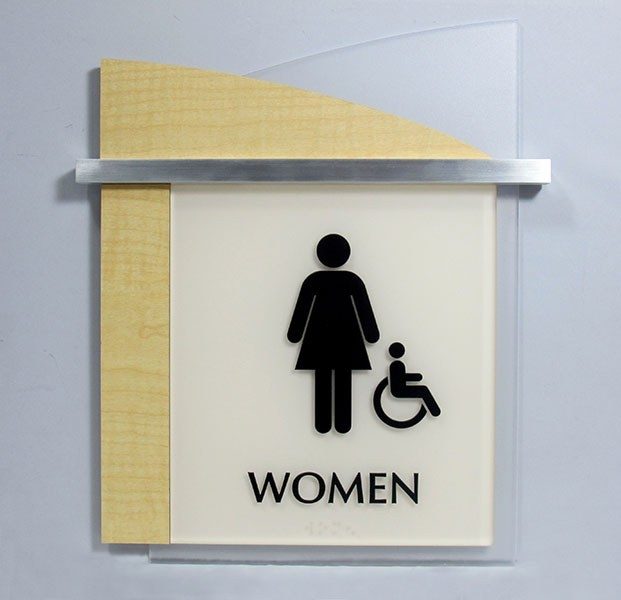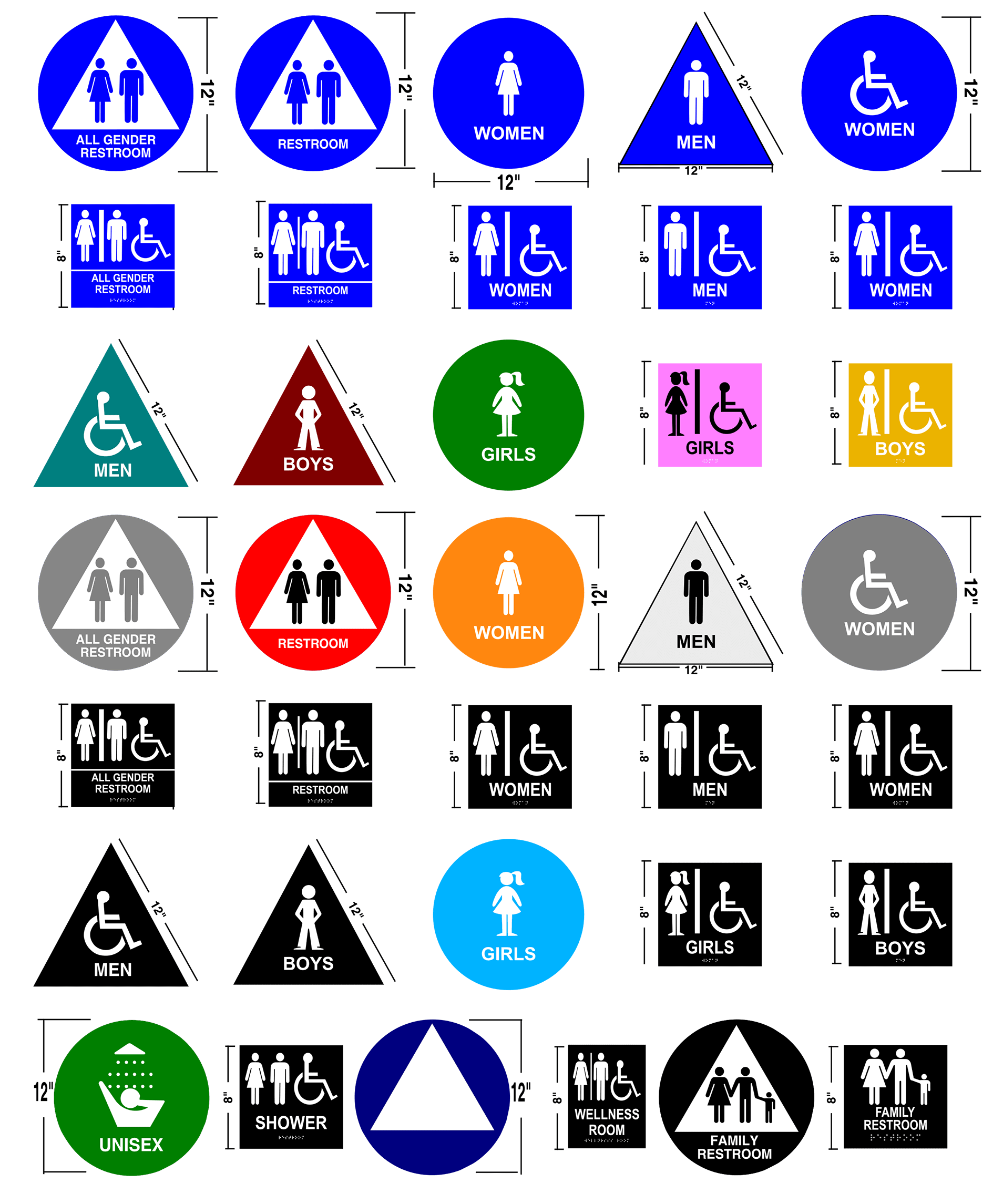Checking Out Innovative Styles for Efficient ADA Signs
Checking Out Innovative Styles for Efficient ADA Signs
Blog Article
ADA Signs: Making Certain Ease Of Access and Compliance in Public Spaces
ADA signs plays a vital function in ensuring ease of access and compliance within public rooms, considerably adding to a comprehensive atmosphere for individuals with impairments. By adhering to ADA criteria, signs not just helps with navigation yet likewise underscores an organization's dedication to variety and equality. As we explore the subtleties of ADA signage, from tactile features to design details, it's critical to take into consideration how these elements coalesce to support the civil liberties of all individuals. What are the common mistakes organizations face in preserving conformity, and how can future trends in signs remain to drive access onward?
Significance of ADA Signage
In modern culture, the significance of ADA signage extends beyond simple conformity with legal requireds to embody a dedication to inclusivity and availability for all individuals. These indications are vital in developing settings where individuals with specials needs can navigate public rooms with the very same ease and independence as those without specials needs. By providing standardized and clear info, ADA signage makes certain that everybody can access centers, services, and information without barriers.
The importance of ADA signs hinges on its ability to improve the lifestyle for people with disabilities by promoting equivalent gain access to. It eliminates the obstacles that could or else prevent their capacity to take part fully in area life. These signs offer as noticeable indicators of an organization's commitment to diversity and equality, mirroring more comprehensive social values that promote the legal rights and self-respect of all individuals.
In addition, ADA signage plays a crucial duty in public safety. By assisting individuals to departures, toilets, and various other crucial centers, it makes sure that all people, despite physical capacity, can leave safely throughout emergencies. In summary, ADA signage is not just a governing demand but a powerful tool for cultivating a inclusive and equitable society.
Crucial Element of Conformity

Positioning is important; indications need to be installed in places that are easily visible and reachable. Generally, signs should be installed between 48 and 60 inches from the ground to guarantee access for both standing and mobility device customers. Tactile elements, such as Braille, are necessary for individuals with aesthetic disabilities, giving crucial details in a non-visual format.
High-contrast colors between the message and background are needed to boost readability for individuals with reduced vision. The ADA mandates specific contrast proportions to make certain clarity. Furthermore, character size is a key consideration, with minimal elevation demands determined by the watching distance to ensure readability from various angles.
Design Factors To Consider for Access
Designing accessible signs calls for a meticulous strategy to ensure it fulfills the requirements of all customers, specifically those with specials needs. This involves thinking about different style aspects that boost readability and usability. Key aspects include the selection of typeface, color contrast, and tactile functions. Typefaces must be sans-serif, with simple and clear letterforms, to facilitate simple analysis. The size of the message is just as crucial, with ADA guidelines suggesting a minimal height based on checking out distance to ensure legibility.
Contrasting shades between message and history are important for visibility, specifically for individuals with visual disabilities. A high comparison ratio aids distinguish the message from its background, enhancing readability under different lighting problems. In addition, tactile components, such as Braille and raised characters, are crucial for people that are blind or have reduced vision. These aspects should be located at a regular elevation and setting to make sure very easy access and understanding.
Additionally, the positioning of signs plays a substantial duty in ease of access. Signs should be mounted in locations that are unhampered and easily reachable. Making sure that signs is placed at ideal heights and angles allows all customers, including those using wheelchairs, to communicate with them properly.
Usual Errors to Avoid

An additional prevalent error is the wrong placement of signage. ADA guidelines define accurate height and place demands to make sure that indicators are obtainable and quickly noticeable by all people, consisting of those utilizing mobility devices. Disregarding these guidelines not only interferes with accessibility however additionally risks non-compliance with legal standards.
Additionally, inadequate comparison in between message and background is a frequent oversight. Ample contrast is necessary for readability, particularly for people with reduced vision. Developers sometimes pick colors that are aesthetically enticing however lack the essential comparison, providing the message challenging to discern.
Lastly, some developers fall short to include tactile elements, such as Braille, which are essential for individuals who are blind. Leaving out these attributes not have a peek at this website only leads to non-compliance with ADA guidelines however also limits accessibility for a section of the population that depends on tactile details.
Future Trends in Signage
Innovations in innovation and raising understanding of inclusivity are shaping the future fads in signage layout. As society becomes a lot more mindful of varied requirements, the integration of smart modern technologies right into signage is acquiring traction. Digital signs, as an example, is progressing to include interactive functions and real-time updates, which can be crucial in giving vibrant info in public spaces. These signs frequently integrate touch screens or gesture-based controls, allowing customers to navigate material tailored to their specific needs.
One more emerging fad is the application of enhanced reality (AR) to enhance customer experience. AR-enabled signage can overlay digital details onto the physical atmosphere, offering aesthetically impaired people with auditory or haptic comments. ADA Signs. This modern technology not just enhances access however additionally creates an appealing experience for all users
Sustainability is likewise a substantial factor affecting signs trends. Green materials and energy-efficient lights remedies are being prioritized to line up with international ecological goals. Advancements in materials science are leading to the advancement of even more weather-resistant and durable signs.
Final Thought
ADA signs plays a crucial duty in assuring accessibility and compliance within public spaces by incorporating tactile aspects, high-contrast shades, and critical positioning. The adherence to ADA requirements not only helps with risk-free navigation for individuals with specials needs yet additionally indicates a company's devotion to variety and inclusivity. By preventing typical blunders and welcoming future patterns, public areas can remain to advance these values, ensuring that the rights and dignity of all people are valued and maintained.
ADA signage plays a crucial duty in assuring availability official statement and compliance within public spaces, considerably contributing to a comprehensive setting for people with specials needs. As we explore the nuances of ADA signs, from responsive features to design intricacies, it's crucial to take into consideration just how these aspects coalesce to copyright the civil liberties of all individuals.In modern society, the value of ADA signs expands past plain compliance with legal mandates to symbolize a commitment to inclusivity and access for all individuals. By offering clear and standardized information, ADA signage makes certain that everyone can access centers, solutions, and info without barriers.
ADA signage plays an essential duty in ensuring availability and compliance within public areas by incorporating tactile aspects, high-contrast colors, and critical positioning. (ADA Signs)
Report this page